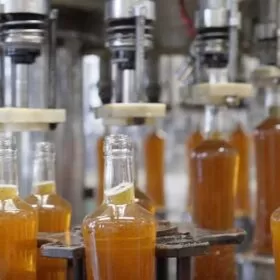Kombucha, a tangy and fizzy fermented tea beverage, has gained immense popularity for its health benefits and unique flavor profiles. Making your own kombucha at home allows you to experiment with various ingredients and create personalized brews. To embark on this brewing journey, it’s crucial to have the right kombucha equipment. In this article, we will explore the importance of kombucha equipment, guide you in choosing the right tools, and provide insights into the essential equipment needed for a successful brewing experience.
What is Kombucha?
Kombucha is a tangy and fizzy fermented beverage made from sweetened tea. It undergoes fermentation through the symbiotic action of bacteria and yeast, known as SCOBY. The SCOBY, which stands for Symbiotic Culture of Bacteria and Yeast, transforms the sweetened tea into a delightful and refreshing drink. During fermentation, the SCOBY consumes the sugar in the tea and produces various beneficial compounds, including organic acids, vitamins, and enzymes. The result is a slightly acidic and effervescent beverage with a unique flavor profile. Kombucha can have a range of flavors, from tangy and tart to fruity and floral, depending on the ingredients used and the fermentation process. It has gained popularity for its potential health benefits, including aiding digestion, boosting the immune system, and supporting gut health. People also enjoy kombucha for its refreshing taste and versatility, as it can be consumed on its own or used as a base for creating delicious flavor combinations with fruits, herbs, or spices.
Why is Kombucha gaining popularity?
Kombucha has been gaining popularity for several reasons. One of the main factors is its potential health benefits. Many people believe that kombucha can aid in digestion, as it contains probiotics that support a healthy gut microbiome. Probiotics are beneficial bacteria that can help improve digestion and promote overall gut health.
Additionally, kombucha is thought to boost the immune system. It contains antioxidants, which help protect the body against damage caused by harmful free radicals. These antioxidants may contribute to a stronger immune response and overall well-being.
Another reason for its popularity is the unique flavor profiles that kombucha offers. It can have a tangy, slightly sour taste that is often combined with fruity or floral undertones. This range of flavors appeals to those seeking a refreshing and enjoyable alternative to traditional beverages.
Furthermore, kombucha is a versatile drink that can be customized to individual preferences. It can be brewed with various types of tea, such as green, black, or herbal, allowing for a wide range of flavor possibilities. Additionally, kombucha can be infused with fruits, herbs, or spices during the fermentation process, further enhancing its taste and creating unique flavor combinations.
Overall, kombucha’s potential health benefits, coupled with its distinct flavors and customization options, have contributed to its growing popularity as a refreshing and health-conscious beverage choice.
The Importance of Kombucha Equipment
To brew high-quality kombucha at home, having the right equipment is crucial. Each piece of equipment plays a specific role in the brewing process, ensuring the success and safety of your homemade kombucha.
Key equipment for brewing Kombucha:
- Brewing vessel: A brewing vessel, such as a glass or ceramic container, is where you will ferment the tea and house the SCOBY (Symbiotic Culture of Bacteria and Yeast). It’s important to choose a vessel that is large enough to hold the desired batch size of kombucha.
- Fermentation cover: A breathable cover is used to protect the brewing vessel while allowing air exchange. It prevents dust, insects, and other contaminants from entering the kombucha during fermentation. Options for fermentation covers include tightly woven cloth, coffee filters, or specially designed covers.
- Airlock: An airlock is a device that fits onto the fermentation cover and allows carbon dioxide produced during fermentation to escape while preventing air from entering. It maintains a controlled fermentation environment and helps prevent unwanted bacteria or mold from contaminating the brew.
- pH testing strips: Monitoring the acidity level of your kombucha is essential for a safe and flavorful brew. pH testing strips allow you to measure the acidity and ensure it falls within the optimal range (around 3.0 to 3.5). This helps prevent the growth of harmful bacteria and ensures the balance of flavors in your kombucha.
- Thermometer: Maintaining the appropriate temperature during fermentation is crucial for the growth of the SCOBY and the desired flavor development. A thermometer helps you monitor the temperature and ensure it stays within the recommended range (usually between 68°F and 85°F or 20°C and 30°C).
By having these key pieces of equipment, you provide a suitable environment for the fermentation process, allowing the SCOBY to thrive and transform the sweetened tea into delicious kombucha.

Choosing the Right Kombucha Equipment
When it comes to selecting the right kombucha equipment, there are several factors to consider. These factors will ensure that you have a seamless and successful brewing experience. Here are the key factors to keep in mind:
1. Size: Choose a brewing vessel that can accommodate the desired batch size of kombucha. Consider how much kombucha you want to brew at a time and select a vessel accordingly. It’s important to have enough space for the SCOBY and the liquid to ferment properly.
2. Material: Opt for brewing vessels made of glass or ceramic. These materials are ideal because they are non-reactive and do not interact with the acidic nature of kombucha. Avoid containers made of plastic or metal, as they can leach chemicals into the brew and affect the flavor and quality of the kombucha.
3. Quality: Invest in high-quality equipment that is food-safe and designed specifically for brewing kombucha. Look for vessels and covers that are durable and able to withstand the fermentation process. Quality equipment will last longer and provide a better brewing experience.
4. Convenience: Consider the ease of cleaning, assembling, and using the equipment. Brewing kombucha requires regular maintenance and cleaning, so choose equipment that is easy to clean and sanitize. Look for covers that fit snugly and are easy to remove and replace. Convenience in handling the equipment will make the brewing process more enjoyable.
In the market, you will find a variety of options, including kombucha brewing kits and individual equipment pieces. These kits often include all the necessary equipment, such as a brewing vessel, fermentation cover, airlock, pH testing strips, and a thermometer. They provide a convenient and comprehensive solution for beginners. Alternatively, you can purchase individual equipment pieces separately based on your specific needs and preferences.
By considering these factors and selecting the right kombucha equipment, you will set yourself up for a successful and enjoyable brewing experience. Remember, investing in high-quality equipment will contribute to the quality and consistency of your homemade kombucha.
Essential Kombucha Brewing Equipment
To get started with kombucha brewing, there are a few essential pieces of equipment that you will need. These tools are fundamental in creating a successful and delicious batch of homemade kombucha. Here are the key items:
1. Brewing vessel and SCOBY: Choose a glass or ceramic container to serve as your brewing vessel. It should be large enough to hold the desired batch size of kombucha. The brewing vessel is where the fermentation process takes place. Additionally, you will need a SCOBY, which stands for Symbiotic Culture of Bacteria and Yeast. The SCOBY is a living culture that contains the necessary microorganisms to transform the sweetened tea into kombucha.
2. Fermentation cover and airlock: It is crucial to protect your brewing vessel during fermentation. A breathable cover is used to prevent dust, debris, and insects from entering while allowing air exchange. You can use a tightly woven cloth, coffee filter, or a specially designed fermentation cover. Additionally, an airlock is attached to the cover to allow carbon dioxide produced during fermentation to escape without allowing air to enter. This helps create an optimal environment for fermentation and prevents contamination.
3. pH testing strips and thermometer: Monitoring the acidity level and temperature during the fermentation process is important for achieving a balanced and safe brew. pH testing strips are used to measure the acidity of the kombucha. The optimal pH range for kombucha is typically around 3.0 to 3.5. A thermometer is used to monitor and control the temperature of the brewing environment. Kombucha fermentation thrives within a temperature range of 68°F to 85°F (20°C to 30°C).
By having these essential pieces of equipment, you are equipped to embark on your kombucha brewing journey. They provide the necessary tools to create a healthy fermentation environment, ensure proper acidity, and maintain optimal temperature conditions for the SCOBY to work its magic.
Additional Equipment for Enhanced Brewing Experience
Once you have the essential kombucha brewing equipment, there are additional tools that can enhance your brewing experience and allow for more creativity. Here are some additional equipment options:
1. Bottles and bottling equipment: After the fermentation process is complete, you’ll need bottles to store and carbonate your finished kombucha. Glass bottles with airtight seals, such as flip-top bottles or those with specialized kombucha lids, are commonly used. These bottles help maintain carbonation and preserve the flavors of your kombucha. Using a funnel and a siphoning tube can make transferring the brewed kombucha from the brewing vessel to the bottles easier and more efficient.
2. Flavoring ingredients and strainers: If you want to add unique flavors to your kombucha, you can experiment with various ingredients such as fruits, herbs, spices, or juices. These ingredients can be added during the secondary fermentation process to infuse different tastes into your kombucha. To ensure a smooth and particle-free brew, it’s helpful to have a fine-mesh strainer or cheesecloth to strain out any solid particles or sediment before bottling.
3. Brewing accessories for convenience: There are various accessories that can simplify and enhance your kombucha brewing process. Consider using a brewing journal or logbook to keep track of your recipes, fermentation times, and flavor combinations. This can help you replicate successful brews and make adjustments for future batches. A digital scale can be useful for accurately measuring ingredients, especially when experimenting with new flavors. Additionally, having a dedicated stirring utensil, such as a long-handled spoon or paddle, can make it easier to mix ingredients and ensure even distribution throughout the brewing vessel.
By incorporating these additional equipment options, you can enhance your kombucha brewing experience and have more control over the flavor profiles and presentation of your homemade kombucha.
Maintaining and Cleaning Kombucha Equipment
Proper maintenance and cleanliness of your kombucha equipment are crucial for successful brewing and to prevent contamination. Here are some guidelines to ensure the longevity and cleanliness of your equipment:
1. Cleaning practices: It is important to clean all your kombucha equipment thoroughly before and after each use. Start by rinsing all components with hot water to remove any residual tea or debris. Then, use mild soap or a food-safe sanitizer to clean the equipment. Avoid using harsh chemicals or antibacterial soaps, as they can leave residues that may be harmful to the SCOBY. Rinse the equipment thoroughly with hot water to remove any soap or sanitizer residues.
2. Storage and maintenance tips: Proper storage and maintenance of your kombucha equipment are essential to prevent contamination and maintain the quality of your brews. Here are some tips:
- Store your equipment in a clean and dry place when not in use. Avoid storing it in areas prone to excessive moisture or where it may come into contact with potential contaminants.
- Ensure that all containers, covers, and utensils are completely dry before storing them. Moisture can create an environment for mold or bacterial growth.
- Periodically inspect your equipment for any signs of damage or wear. Replace any cracked or compromised containers, covers, or utensils to maintain the integrity of your brewing process.
- It’s a good practice to label or store your equipment separately for kombucha brewing purposes. This reduces the risk of accidentally using them for other purposes and potentially introducing contaminants into your brews.
By following these cleaning, storage, and maintenance practices, you can ensure the cleanliness of your kombucha equipment and create an environment conducive to successful brewing. Remember, maintaining hygiene and cleanliness is essential for the health and quality of your kombucha.
Troubleshooting Common Equipment Issues
While brewing kombucha, you may encounter some common equipment-related issues. Here are a few problems and their solutions:
1. Mold growth: If you notice mold on your SCOBY or in the brewing vessel, it is essential to address the issue promptly. Mold contamination can occur due to unsanitary conditions or exposure to airborne contaminants. To resolve this problem, follow these steps:
- Discard the entire batch of kombucha, including the SCOBY and the liquid.
- Thoroughly clean and sanitize all your equipment, including the brewing vessel, cover, and utensils.
- Obtain a new, healthy SCOBY from a trusted source or from a previous batch.
- Start fresh with a new batch of sweetened tea and introduce the new SCOBY.
2. Slow fermentation or no carbonation: If your kombucha is taking longer than usual to ferment or lacks carbonation, there may be a few factors to consider:
- Check the temperature of the fermentation environment. Kombucha ferments best in the temperature range of 68°F to 85°F (20°C to 30°C). Adjusting the temperature to within this range can help speed up the fermentation process.
- Ensure that you are using an adequate amount of sugar for the yeast to consume during fermentation. Adding a small amount of additional sugar can help kickstart the fermentation process.
- Check the health of your SCOBY. If it appears weak or unhealthy, it may not be fermenting efficiently. In this case, consider obtaining a new SCOBY and starting a fresh batch.
3. Off-flavors or unusual taste: If your kombucha has developed off-flavors or an unusual taste, it could be due to equipment contamination or prolonged fermentation. Here’s what you can do:
- Ensure that all your equipment is thoroughly cleaned and sanitized before each use. Contaminants can impact the flavor of your brew.
- Monitor the fermentation time carefully. Over-fermentation can result in overly sour or vinegary flavors. Taste your kombucha at regular intervals during the fermentation process to find the desired balance of flavors.
- Experiment with different tea types or adjust the brewing time to achieve the desired taste profile. The type of tea used and the brewing duration can greatly influence the flavor of your kombucha.
By troubleshooting these common equipment issues, you can ensure the quality and consistency of your homemade kombucha. Remember to maintain cleanliness, monitor fermentation conditions, and make necessary adjustments to achieve the desired flavors in your brews.
Conclusion
Investing in the right kombucha equipment is essential for brewing delicious and healthy homemade kombucha. From the brewing vessel and SCOBY to the fermentation cover, pH testing strips, and thermometer, each piece of equipment plays a crucial role in the fermentation process. Additional tools like bottles, bottling equipment, flavoring ingredients, and brewing accessories enhance your brewing experience and allow for creativity. Proper maintenance, cleaning practices, and troubleshooting common issues will help you achieve optimal results with your kombucha brews.






